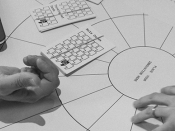Por Cristóvão Dias (CFTC - Faculdade de Ciências da Universidade de Lisboa).
Abstract: Tissue engineering relies upon a control over cell proliferation on biocompatible matrices, known as scaffolds. These scaffolds are typically synthesized under controlled conditions and implemented in vivo afterwards, what raises several problems related to biocompatibility. An alternative is to obtain the scaffolds in vivo from the spontaneous self organization of colloidal particles mediated by the cells that will later form the tissue. This is a typical problem where theoretical insight and numerical simulations could be of help to optimize the design of the scaffolds. We studied the dynamics of self-organization of the scaffold by means of large-scale molecular dynamics simulations, lattice kinetic Monte Carlo simulations, and analytically. As the kinetics of this colloid/cell system evolves, aggregation occurs, and the physical properties of the final structure depend on the ratio between the two species. We study the effect of cell-cell adhesion on the collective dynamics leading to the scaffold self-assembly. In this talk, I will show how a tissue engineering problem can be approached from a physics perspective combining different techniques...
Short bio: Cristóvão Dias obtained his PhD in Physics from the University of Minho in 2011. Since then, his research has focused on non-equilibrium phenomena, over multiple scales, from the nanoscale (thin films and catalysis) to the micron scale (soft matter materials). In 2012, he was hired as a postdoc at CFTC in the context of an FCT project in a research line of excellence (EXCL). In 2016, He was awarded an individual postdoc fellowship from FCT and, in 2018, he was awarded an CEEC Individual contract as an Assistant Researcher from FCT.













